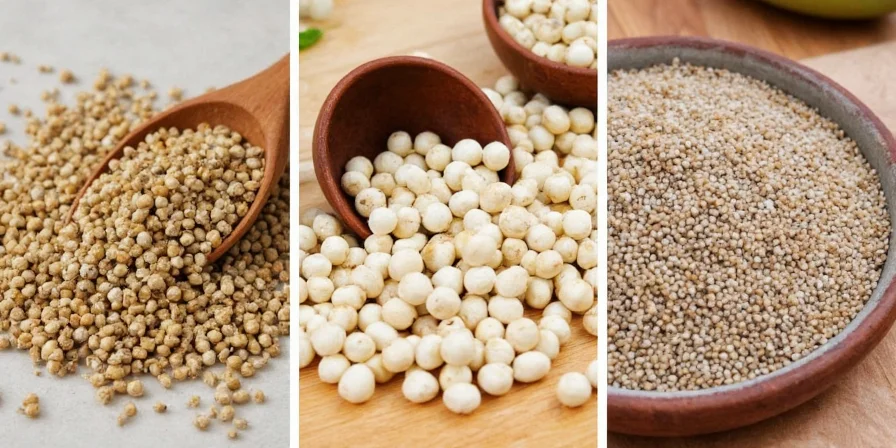
When you're out of white pepper, the best substitutes are green peppercorns (1:1 ratio), finely ground black pepper (½ tsp per 1 tsp white pepper), or a coriander-cayenne blend (¾ tsp coriander + ¼ tsp cayenne). The right choice depends on your dish: green peppercorns work best for creamy sauces where visual appearance matters, while black pepper works for darker dishes where specks won't show.
White Pepper Substitute Cheat Sheet
Don't panic when your white pepper runs out. These practical alternatives work immediately with common pantry items:
- For creamy sauces and light dishes: Finely crushed green peppercorns (1:1 ratio)
- For soups and stews: Freshly ground black pepper (use half the amount)
- For grain dishes and roasted vegetables: Coriander-cayenne blend (¾ tsp coriander + ¼ tsp cayenne)
- For vinaigrettes and fruit salsas: Pink peppercorns (⅔ tsp per 1 tsp white pepper)
- For slow-cooked meats and baked goods: Allspice (⅜ tsp per 1 tsp white pepper)

Why White Pepper Matters in Cooking
White pepper provides mild heat without dark specks, making it essential for:
- Cream sauces and béchamel
- White wine reductions
- Pale soups and consommés
The right substitute maintains both flavor balance and visual appeal - crucial factors most guides overlook.
Best White Pepper Substitutes for Home Cooks
1. Green Peppercorns (Finely Crushed)
Best for: Creamy sauces, seafood dishes, light-colored foods
Green peppercorns offer the closest visual match to white pepper. Crush them to powder consistency for seamless integration.
- Flavor: Mild citrus notes with floral undertones
- Visual: Nearly invisible when finely processed
- Ratio: 1:1 replacement (lightly toast first)

2. Freshly Ground Black Pepper
Best for: Dark stews, braises, meat dishes
Use when visual appearance isn't critical. Black pepper delivers stronger heat, so use less.
- Flavor: More pungent with woody notes
- Visual: Noticeable black specks
- Ratio: ½ tsp per 1 tsp white pepper

3. Coriander-Cayenne Blend
Best for: Grain dishes, roasted vegetables, light-colored recipes
This pantry-friendly option mimics white pepper's floral notes while providing controlled heat.
- Flavor: Citrusy with balanced warmth
- Visual: Neutral appearance (no discoloration)
- Ratio: ¾ tsp coriander + ¼ tsp cayenne per 1 tsp white pepper

4. Pink Peppercorns
Best for: Vinaigrettes, fruit salsas, acidic preparations
Provides similar tartness to white pepper's fermented profile but may add slight pink tint.
- Flavor: Berry-like with subtle warmth
- Visual: Slight pink tint in liquid bases
- Ratio: ⅔ tsp per 1 tsp white pepper

5. Allspice
Best for: Slow-cooked meats, baked goods, spice cakes
Delivers comparable warmth without discoloration but requires careful measurement.
- Flavor: Balanced sweet-spice notes
- Visual: No discoloration
- Ratio: ⅜ tsp per 1 tsp white pepper

Quick Reference: White Pepper Substitutes Comparison
| Substitute | Flavor Match | Visual Match | Best For | Ratio |
|---|---|---|---|---|
| Green Peppercorns | ★★★★☆ | ★★★★☆ | Cream sauces, seafood | 1:1 |
| Black Pepper | ★★★☆☆ | ★☆☆☆☆ | Dark stews, braises | ½:1 |
| Coriander-Cayenne | ★★★☆☆ | ★★★★★ | Grain dishes, roasted veggies | ¾+¼:1 |
| Pink Peppercorns | ★★★☆☆ | ★★☆☆☆ | Vinaigrettes, fruit salsas | ⅔:1 |
| Allspice | ★★☆☆☆ | ★★★★★ | Slow-cooked meats, baking | ⅜:1 |
Pro Tips for Using White Pepper Substitutes
- For perfect creamy sauces: Steep green peppercorns in warm cream for 10 minutes, then strain to remove particles while keeping flavor
- To prevent overpowering heat: Add half your substitute during cooking and the rest at the end for balanced flavor
- When cooking French recipes: Green peppercorns work best in béchamel and other white sauces
- For baking applications: Allspice works well in gingerbread at ⅜ ratio; avoid black pepper as heat intensifies during baking
- Storage tip: Pre-mix coriander-cayenne blends in small batches and store in airtight containers for up to 3 weeks
Common White Pepper Substitute Questions
Can I use black pepper instead of white pepper?
Yes, but with limitations. Black pepper works best in dark dishes where the specks won't show. For light dishes like cream sauces, use only half the amount (½ tsp black pepper per 1 tsp white pepper) to avoid overwhelming heat and visible black flecks.
What's the closest substitute for white pepper in creamy sauces?
Finely crushed green peppercorns are the best substitute for creamy sauces. Process them to near-powder consistency for seamless integration that maintains the sauce's visual appeal while delivering similar mild heat and floral notes.
How do I substitute white pepper in baking?
For baking, allspice works best at a ⅜:1 ratio in gingerbread or spice cakes. Avoid black pepper as its sharpness intensifies during baking. For light-colored cakes, use the coriander-cayenne blend sparingly to maintain visual purity while adding subtle warmth.
Do white pepper substitutes affect shelf life?
Most dry substitutes don't affect shelf life when used at recommended ratios. Green peppercorns may reduce shelf life in wet applications due to higher moisture content. Pink peppercorns introduce slight acidity that can accelerate oxidation in some dishes.
Final Thoughts: Practical Substitution Strategy
Running out of white pepper doesn't mean compromising your dish. The right substitute depends on two factors: your recipe's color requirements and flavor profile needs. For most home cooks, green peppercorns (for light dishes) or the coriander-cayenne blend (for visual purity) provide the most versatile solutions using common pantry items. Keep this guide handy for your next cooking emergency - these practical alternatives will save your recipes without requiring special ingredients.











 浙公网安备
33010002000092号
浙公网安备
33010002000092号 浙B2-20120091-4
浙B2-20120091-4